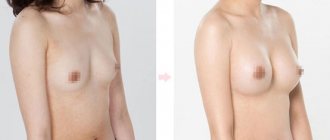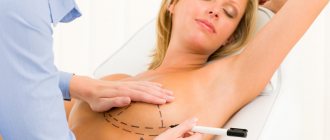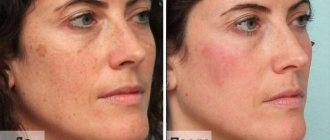The health of a woman's breasts is inseparable from the health of the body as a whole. But often, even with undisturbed general health, a woman may be bothered by discomfort in the mammary glands. This is how mastopathy manifests itself - a common pathology of the mammary glands. Why does it occur? What threats does it pose and how to deal with the problem? Mammologist-oncologist at the Women's Medical Center, a doctor of the highest category, Irina Petrova, .
What is mastopathy of the mammary glands
The pathological condition develops against the background of hormonal imbalance. It is preceded by excessive production of the hormones estrogen or prolactin, which causes the glandular tissue in the breast structure to grow and increase in volume. Increase the risk of disease:
- disruption of the thyroid gland and decreased production of hormones;
- obesity;
- liver diseases;
- gynecological diseases;
- stressful situations.
In recent years, the number of women suffering from this disease has been growing rapidly. According to mammologist-oncologist Irina Petrova, pathology is detected in 97% of women who come for an appointment. The specialist attributes this to the deterioration of the environmental background, which causes gene mutations and widespread disease. And also with the changing lifestyle of a modern woman.
“Previously, women often gave birth and breastfed for a long time,” comments Petrova. — During pregnancy and breastfeeding, mastopathy does not develop. But it is impossible to speak unequivocally about reducing the risk of the disease with frequent childbirth, since a complex of reasons leads to the development of pathology: genetic failure, hormonal imbalance, stress. All this causes changes in the mammary glands.”
Mammoplasty of the mammary glands of the breast, which results in shape correction and enlargement
Breasts and mammoplasty, full and toned, are an integral element of an ideal figure and the dream of every woman. She excites the imagination of men from century to century. Each time period makes its own adjustments to fashion; mammoplasty is currently the focus of women with full, firm breasts. It is this form that is considered the height of eroticism and attractiveness. Women who have given birth are so familiar with the problem of stretching the skin on the chest, loss of elasticity and change in shape not for the better. Fortunately, medicine does not stand still, and long-awaited methods of mammoplasty have been invented to solve women's problems and maintain women's breasts in a healthy condition with the help of the drug Mabusten.
Mammoplasty method
The mammoplasty method is a plastic surgery that results in breast shape correction and breast enlargement. Using the mammoplasty method, surgeons are able to eliminate congenital asymmetry of the mammary glands and restore its original shape, damaged as a result of pregnancy and lactation. According to statistics, approximately a million representatives of the fair sex resort to mammoplasty as a way to solve the problem. And, therefore, the implementation of this operation is brought to perfection.
Who is eligible for mammoplasty?
Before breast augmentation surgery
After breast augmentation surgery
Complications after breast surgery
Pain after breast augmentation
There are a number of prohibitions on performing mammoplasty: - thyroid disease; - diabetes; - blood pressure exceeding the level; — infectious and oncological diseases; — fibrous mastopathy, — disease of the cardiovascular system. The feeding period is also included in the above list. To carry out the operation, you must wait about a year after weaning the child. It is necessary to accurately determine the volume, shape and size that you dream of getting after mammoplasty. And it is especially important to coordinate your choice with your doctor.
Implant selection
The design principle of all implants is the same. This is a special gel contained in an elastic silicone shell. It is similar to gland tissue and gives a natural appearance to the breast when touched. The differences between implants lie in the structure of their shell and shape. The most popular at the moment is “a drop running down the wall.” This shape hides the contours and looks harmonious. The round shape also looks very attractive. And large implants are suitable for ideal and healthy breasts that simply need to be enlarged. Please note that the more rough the texture, the lower the risk of possible complications. It is also necessary to take into account the individual characteristics of the patient.
Effective treatment of mammary adenosis >>>
Surgical technique for mammoplasty
It is determined by two components: 1. Surgical access. This is where the cut will be made. 2. Placement of the implant in the relatively large chest muscle. What determines the choice of techniques? From several indicators: - subcutaneous tissue, its characteristics; — skin condition; - sagging breasts; -location of the mammary glands; - the desire of the patient. For a woman who has developed glandular tissue and a layer of fat, the doctor will insert an implant under the mammary gland. If the patient being operated on has thin skin, then it would be correct to use the axillary placement. The implant is placed behind the pectoral muscle. This method does not interfere with breast examination. Disadvantages include a long recovery period and some pain.
Combined method
Combined method of mammoplasty. This is when part of the implant is placed under the armpit and the rest is under the breast. The choice is individual. This also applies to the incision site. Quite a lot of surgeons use submammary access in practice. This is when the seam lies in the natural fold located under the breast. This method is as reliable as possible because the entire area is under control. In theory, the traces left behind should be invisible, but in practice they do not disappear completely. Administration through the axilla would be more appropriate. The stitch dissolves quite quickly. But the axillary region is a very delicate area; many vessels and lymph nodes are concentrated here. And the art of a specialist is to not affect them when performing an operation. Perioral access is the same without trace. The incision is made along the areola of the nipple. But keep in mind that a violation of the integrity of this jeweled organ can cause mastopathy and cyst formation. Only a highly qualified professional can carry it out. Endoscopic access is in little demand. It's outdated. Silicone bags are used instead of implants. A pair of empty capsules are inserted into the chest along tracks through the abdomen, then they are filled with a saline solution.
Symptoms and diagnoses
Prevention of mastopathy
Symptoms of fibrous mastopathy
Fibrous nodular mastopathy
Fibrofatty mastopathy
Mastopathy after 40 years
Preparation for the operation
1. Two weeks before the operation and until the end of the recovery period you will have to refrain from drinking alcohol and smoking. 2. Refusal of hormonal drugs and drugs that can affect blood clotting. 3. You can’t play with weights after mammoplasty. This can negate the entire result. Its duration is up to two hours. First, control points for the incision are outlined, then anesthesia is carried out, and the operation itself is carried out. If the outcome of the operation is favorable, you can return home the next day.
Diagnoses, treatment and prescriptions
Chronic mastopathy in women
Hormone tests for mastopathy
Hormonal disorders in mastopathy
Treatment of cystic fibroadenomatosis
Hormones and hormonal status in women
Postoperative period
The marks left by the cuts will disappear in approximately ninety days. The stitches are removed after a few days. Then the swelling will go away. It is recommended not to remove special underwear for about a month. Contraindicated: - sports; - Tan; -carry weights; -Do massage. The operation does not in any way affect the birth of children or breastfeeding. And most importantly, you will finally get what you have dreamed of for so long - sexuality and the adoration of men. But, inspired by hope, treat this procedure with all responsibility.
www.mabusten.com
Types of breast mastopathy
Pathological tissue growth in the breast structure occurs unevenly. In this case, small cavities filled with liquid contents, the so-called cysts, can form in the mammary glands. In this case, cystic mastopathy is diagnosed.
The proliferation of glandular tissue may be accompanied by its transformation into connective tissue, with the appearance of scar changes. This process is characteristic of fibrous mastopathy.
Often the processes occur simultaneously: the formation of multiple small cysts and the formation of fibrous tissue allows the doctor to diagnose fibrocystic mastopathy.
“The disease is distinguished by the component, the content of which increases in the mammary glands,” clarifies Irina Petrova. — Mastopathy can be cystic, fibrous or glandular. But, from the point of view of danger, for a woman the disease is divided into two types - diffuse and nodular.”
Does the risk of cancer increase with the disease and plastic surgery?
Some time ago, one could come across works indicating that silicone, which was used for operations on the mammary glands, is dangerous, especially if mammoplasty is performed for diffuse mastopathy or some other form of it.
But for the most part this applies to old samples of the material, as well as methods when the gel is diffusely injected directly into the tissue. In this case, silicone may even reach the baby during lactation, so it is recommended to refrain from breastfeeding.
As for modern endoprostheses, which are placed behind the muscles or between them, they do not pose any danger to the woman and her baby (in case of pregnancy).
Even if a girl has mastopathy, but only if an oncological process is excluded. In addition, modern surgical technologies make it possible to install implants without disturbing the glandular tissue of the breast. But this is only possible if no other additional correction is needed.
Features of diffuse mastopathy
With this pathology, the component is distributed evenly in the mammary gland. The breasts may become painful, and discomfort intensifies on the eve of menstruation. As the disease progresses, the discomfort becomes constant, and during self-examination of the breast, lumps that were not there before may be felt.
Diffuse mastopathy worsens a woman’s quality of life, causing discomfort and constant anxiety. But the disease itself does not pose a threat to life. Your health can be corrected with timely, comprehensive treatment. Doctors today have enough tools in their arsenal to help normalize a woman’s condition.
Contraindications for surgery
Close attention has been paid to the mammary glands for decades. These include numerous operations to correct shape and size, as well as the development of advanced technologies that make it possible to diagnose benign and malignant diseases in the early stages due to the increase in breast cancer throughout the world.
Even 10 - 15 years ago it was believed that mammoplasty should not be performed for mastopathy of any form. The material used for endoprosthetics increased the risk of malignant neoplasms, and sometimes the cancer was simply not diagnosed before the operation, although it was already at an early stage.
Today, mastopathy in 95% of cases does not in any way affect the possibilities of mammoplasty. This is due to the following:
- Only high-quality and absolutely safe implants are used;
- There are various methods for installing an endoprosthesis; preference is given to one method or another in a specific situation;
- there is a large arsenal of diagnostic procedures that allow you to monitor the mammary glands after mammoplasty;
- Histological examination methods have been improved, in which the benign nature of the process in the breast can be confirmed with 100% probability.
However, despite this, the feasibility and safety of mammoplasty is determined by the doctor in each specific case. The generally accepted practice is the following:
- If formations (cysts or fibroadenomas) larger than 1 cm are found in the mammary glands, they must be removed. This can be performed during mammoplasty, then the material should be sent for urgent histological examination, and only after confirmation of benign growth can the operation be continued.
- If this is not possible, or the surgeon does not have sufficient knowledge in this area, removal of the lesions occurs as a preparatory operation, and mammoplasty itself is performed a second time.
- If mastopathy has a pronounced fibrous component, the likelihood of getting the expected result is less. This is due to the fact that such breast tissue is less extensible, and this creates certain difficulties when installing implants and subsequent uniform distribution of tissue on it.
In any case, the operating surgeon, when a woman who wants to perform mammoplasty comes to him, prescribes a set of examinations to clarify the presence of pathological processes in the organ.
The minimum includes the following:
- Ultrasound examination of the mammary glands, and, if necessary, mammography.
- A blood test for tumor markers; it is especially important to take them if any formations are detected. Most often this is SA-15-3.
- Additionally, MRI or CT, ductography (examination of ducts) and others.
The danger of nodular mastopathy
With the development of this form of the disease, nodules—neoplasms—form in the mammary glands. Their size can vary: from small, about the size of a pea, to a walnut, if the woman “did not notice” the progression of the disease for a long time. The “knot” can be felt tactilely, the mammary glands become painful and enlarged, regardless of the day of the menstrual cycle. There may be enlargement of the lymph nodes in the armpits.
“The danger of nodular mastopathy is in the intensive division of cells in this area,” continues Irina Petrova. “It often occurs against the background of a cancerous process in the mammary gland, when one of the ducts is already blocked by tumor cells. Therefore, nodular mastopathy is usually removed surgically, but not because the disease itself or the lump that has formed in the mammary gland poses a danger. But because there is a high probability of a tumor process in the breast and the development of cancer at the cellular level.”
Breast enlargement for mastopathy: reality or a pipe dream?
We welcome every traveler wandering along the paths of the Internet to our page. We are glad that you visited our website. Today we are talking about the beauty of women's breasts. And about whether a woman with mastopathy can dream of improving her bust shape with the help of augmentation mammoplasty. Join the conversation, and after reading the article you will know the answer.
Breast surgery and fibrocystic disease
Every woman wants to feel beautiful and desirable, to have a full, toned bust. For some, it is not a problem to undergo breast surgery, but for others, they do not know whether they can afford the miracle of surgery. The reason for this is a health condition called mastopathy or cystic fibrosis disease.
Many conservative methods (massage and any procedures that stimulate blood flow to the gland tissues) are not available to women suffering from this disease. Is surgical breast enlargement possible for mastopathy? This question worries thousands of women. After all, every third person, according to statistics, is familiar with one of the forms of this disease.
If this topic is relevant to you, we are happy to improve your mood. In general, mastopathy is not a contraindication for mammoplasty, including augmentation.
Is it possible for you to have surgery? An accurate, reliable answer is not possible without consulting a mammologist. Only after this specialist gives the go-ahead for surgery, the plastic surgeon evaluates his skills, your condition, and says a confident “yes.”
If the cherished “yes” has been heard, remember, endoprosthetics is not a reason to stop treating mastopathy. The disease is chronic and requires constant medical supervision.
The only real inconvenience associated with prosthetics awaits you at an appointment with an ultrasound diagnostician. In some cases, the presence of an endoprosthesis reduces the reliability of the information obtained from an ultrasound examination.
A little about mastopathy
Mastopathy is the collective name for several types of pathology of the glandular tissue of the breast associated with its growth:
- With a predominance of cystic formations.
- With active fibrosis.
- With the growth of the glandular tissues themselves.
The pathology is benign. The following forms are distinguished:
- Nodular (with fibrous formations ranging in size from a pea to a walnut).
- Diffuse.
The doctor’s actions: his consent to operate on you, the choice of the type of access to the implantation site and a number of his other decisions will depend on the form of your disease.
To use prosthetics or not?
If fibrocystic mastopathy is diagnosed at the initial stage, experts will advise treating the disease. Of course, treated mastopathy is not a cured disease. But in most cases, after a course of treatment, surgery becomes possible. In this case, the surgeon’s actions may be as follows:
- If there is a single and small fibrous lesion (up to 1 cm), the surgeon may not do anything to remove it, just insert implants.
- If the lesions are large enough (from 1-1.5 cm), they can be removed during surgery.
If the doctor does not have the skills to remove cysts or there are some technical difficulties in combining the intervention to remove the fibrous node and implantation, mammoplasty can be performed in two stages:
- Cyst removal.
- Endoprosthesis implantation.
With a large tumor size with a predominance of fibrous tissue, the chance of obtaining a good result after surgery, as well as of performing the operation itself, is lower. Connective tissue growths are little elastic. This makes it difficult to insert the prosthesis.
Does the risk of fibrocystic tumor malignancy increase with implantation?
Until recently, it was believed that silicone breasts were a giant step towards breast cancer, especially if the implantation was performed for diffuse mastopathy. Today, manufacturers of modern endoprostheses assure that there is no such danger. Silicone:
- does not enter the gland tissue, while maintaining the integrity of the capsule;
- does not diffuse and is not absorbed when it breaks;
- does not pass into milk if a woman becomes pregnant after implantation
That is, the risk for a woman and her possible offspring when implants are introduced is minimal. But if you enlarge the breast with access through the areola, then with mastopathy the risk of fibrosis of fairly large areas of glandular tissue increases. This method of gaining access to the site of implantation of the prosthesis is traumatic for the gland, and its scarring is a fibrotic process.
It is up to you to decide whether to undergo breast surgery with endoprosthetics for mastopathy. But we hope that this article helped each of our readers who are interested in changing bust parameters make the right decision that is appropriate to the situation. Regardless of whether they suffer from fibrocystic disease or not.
We say goodbye until new articles. Read our news, share it with friends.
krasivayagrud.ru
Mastopathy and breast cancer
The disease is often called a harbinger of cancer or a condition that increases the risk of breast cancer. But, according to Irina Petrova, it is wrong to interpret this disease this way. Mastopathy does not increase the risk of cancer and in itself is neither a harbinger nor a symptom of cancer.
“We are saying that mastopathy is a good background for the development of breast cancer,” the specialist notes. - Just as a smoker has a good background for the development of lung cancer, and a patient with an ulcer has a good background for the development of stomach cancer. But the presence of a background does not mean that cancer will definitely occur. It all depends on the functioning of the body’s immune system, since more than a million cancer cells are released in the human body every day. If the immune system copes with them, oncology does not develop. Therefore, mastopathy cannot be regarded as a precancerous condition.”
Mastopathy and the reasons for its appearance
There are no reliable and unambiguous mechanisms for the development of mastopathy yet. Existing theories and assumptions make it possible, to some extent, to treat a disease from which it is not always possible to radically get rid of it.
An important point, including taking into account subsequent mammoplasty, is that mastopathy never turns into cancer. But against the background of such a condition of the mammary glands, malignant neoplasms are more common.
According to statistics, today every third woman with a thorough examination can detect certain signs of the disease.
According to available scientific data, the following can be said about mastopathy:
- this is a disease that reflects the state of a woman’s entire hormonal system, and not a separate organ;
- in most cases, mastopathy reveals an increase in the amount of estrogen and insufficiency of the second phase of the cycle;
- against the background of the disease, premenstrual syndrome has a more vivid clinical picture;
- mastopathy, even with treatment, rarely goes away; in some cases (fibroadenomas, cysts and others) it is subjected to surgical treatment;
- There are diffuse and focal forms (cysts, fibroadenomas). Doctors always treat the latter with caution, since they can be confused with malignant neoplasms. Therefore, more aggressive tactics are applied to them - removal and mandatory subsequent histological examination.
We recommend reading the article about the pros and cons of mammoplasty. From it you will learn about the advantages and disadvantages of the procedure, prohibitions after the operation.
Risk reduction
It is impossible to avoid or guarantee protection from mastopathy. There is no cure or way to reduce the risk of its occurrence. But doctors note several patterns.
1. Taking oral contraceptives at an early age. According to Irina Petrova, if girls start taking contraceptives early, as a rule, the disease does not develop even in adulthood.
2. Age after 40 years. At this time, the glandular tissue in the breast practically disappears, so the likelihood of the disease occurring is significantly reduced. But this does not mean that if mastopathy occurred earlier, then after 40 years it will go away or be less of a concern. If you have a disease, its course should be monitored and regularly visited by a mammologist.
Proper nutrition, taking care of the liver, and maintaining a normal weight can reduce the risk of mastopathy. And, of course, attention to your health. According to Irina Petrova, every girl over the age of 16 should visit a mammologist every year. You should definitely come to an appointment if you are planning a pregnancy. And if the condition of the breast raises even the slightest suspicions and questions, you need to contact a specialist as soon as possible.
How mammoplasty can harm mastopathy
So, the approach to performing mammoplasty in the presence of signs of mastopathy should be individual; there is no single algorithm and management tactics.
If a woman is not examined on the eve of surgery, then even cysts and fibroadenomas larger than 1 cm may not be detected, which in the future can create certain difficulties in their treatment and even diagnosis.
In addition to the fact that it is necessary to find out the presence of the disease before mammoplasty, it should be taken into account that some types of examination after installation of the implant will not be so informative. The following features in the diagnosis of diseases after surgery can be highlighted:
- The performed mammoplasty has practically no effect on ultrasound examination. But the problem is that this examination is informative only until the age of 40-45, after which its diagnostic value drops sharply.
- The biggest changes concern mammography. It is this type of examination that is the most revealing, especially after the mammary glands undergo fatty involution.
- Performing high-quality mammography has some difficulties after mammoplasty. The fact is that the implant can block some areas during an X-ray scan, and if the pathological foci are located there, they will go unnoticed. The area under study is especially shaded if the endoprosthesis is installed above the pectoral muscles. Therefore, it is advisable to carry out the correction with the placement of the implants underneath them, then the inaccessible area is minimal. Operating surgeons must take this feature into account when planning the course of the operation.
- The installed implants do not affect the performance of CT and MRI in any way, but these methods are not routine and are carried out only when indicated.
- Some women are also worried about whether it is possible to undergo fluorographic examination of the mammary glands after mammoplasty. Indeed, the installed implants will be visible, but they will not affect the quality of the examination and the percentage of detection of lung diseases.
In addition, after mammoplasty, a woman remains swollen in the mammary gland for a long time, and during the intervention itself, blood and lymphatic vessels are damaged. This can somewhat aggravate the course of mastopathy and intensify its manifestations. Therefore, if the disease is present, it is necessary to undergo preventive courses of treatment both before and after surgery.
Watch the video about the procedure:
How to treat mastopathy
Despite the fact that the disease causes serious discomfort and may be accompanied by the development of lumps in the mammary glands, specialists do not set themselves the task of treating mastopathy.
“If someone tells you that they can cure mastopathy, you need to turn around and leave such a doctor,” comments mammologist-oncologist Irina Petrova. — Mastopathy cannot be cured. We can cure her complications, remove pain, improve the woman’s well-being and condition, but nothing more. Mastopathy goes away on its own with age, when the amount of estrogen in a woman’s body naturally decreases. This happens around menopause."
The doctor chooses tactics to combat the symptoms that accompany the development of mastopathy based on the patient’s well-being, health status and the reasons that caused the development of the disease.
“The doctor must evaluate what kind of mastopathy it is, what is causing it: excess estrogen, prolactin, disruption of the thyroid gland or another reason,” continues Irina Petrova. — The specialist collects anamnesis and only then chooses treatment tactics. We have a huge number of drugs that we can use to help a woman. These could be hormonal drugs to correct hormonal levels or herbal remedies that normalize well-being.”
However, there cannot be a single recommendation for the treatment of mastopathy. Each case is individual, as it is caused by various reasons and has its own symptoms. There is no universal therapy that will help all women without exception. Depending on the examination results, the doctor will clarify the treatment tactics.
In one case, taking medications will be enough, in another, surgery will be required, in the third, self-monitoring and observation can be done. But it is important that this recommendation is given by a specialist, then you don’t have to worry about breast health.
Self-diagnosis of mastopathy
“You can live with mastopathy,” notes Irina Petrova. “You don’t need to be afraid of it, but it’s important to pay attention to your health and visit a doctor regularly. And do this not only when something bothers you. You need to undergo an examination by a mammologist even when everything is normal. The recommended frequency of visits is once every 6–12 months.”
A specialist considers regular examinations of the mammary glands at home to be a good way to monitor breast health. This should be done often, monthly, from the 6th to the 12th day of the menstrual cycle, when the breasts are “calm” and relaxed. It is necessary to examine the armpits and mammary glands and palpate them with gentle movements. But without prejudice: it is important to understand that the structure of the breast is heterogeneous, that it has more and less dense areas. With regular monitoring, a woman gets used to the condition of her mammary glands and if something “new” appears in them, she can consult a doctor in time.
According to Irina Petrova, in order for self-diagnosis to be informative, it is worth discussing the tactics of its implementation with your doctor. The specialist will explain what to look for and how to properly feel your breasts. Gradually, such an examination will become a daily ritual, which will reduce the risk of progression of mastopathy and will allow early detection of a much more formidable enemy - breast cancer.
If suspicions arise during self-diagnosis, you should consult a doctor immediately. Delay is dangerous, since the longer the disease develops uncontrollably, the higher the risk of its undesirable outcome.
Breast surgery for mastopathy
Breast enlargement cream
How effective are hormonal drugs for breast enlargement, which supposedly have an enlargement effect? Can breast enlargement cream or ointment really work? Let's figure it out.
How to enlarge breasts at home
What could be more tempting: stay at home, eat the “right” foods, take dietary supplements of natural origin, do the right exercises and massages, get healthy and improve your bust at the same time. Why not a fairy tale?
Massage for breast enlargement
Websites that talk about supposedly effective ways to enlarge breasts using massage also often advertise various dietary supplements that, in combination with massage, supposedly help to enlarge breasts.
How to visually enlarge breasts
Almost all women want to visually enlarge their bust, which is why many of them are puzzled by the question: how to make their breasts larger visually, are there clothes that increase breast size?
How to enlarge breasts using folk remedies
This method cannot give really good results, but given that it is given to you practically free of charge, why not try using this method to enlarge your breasts at least a little?
Breast enlargement huge size
The answer to the question “how to increase the size of a woman’s breasts” is largely determined by the choice of implant for breast surgery.
Breast surgery after mastectomy
Breast cancer occupies a leading position among diseases of the mammary glands. With this disease, the entire affected breast is often removed, that is, a mastectomy is performed.
Contraindications to breast surgery
Like any other plastic surgery, breast augmentation has contraindications. They should not be neglected, because they are all justified, and ignoring them can lead not only to poor-quality results of the operation, but also create significant health risks.
Breast implants
There are a very large number of different implant options, so all this variety can satisfy the wishes of any patient.
Breast augmentation without anesthesia
Why is it that during breast augmentation that general anesthesia is needed, and not local anesthesia, during which the woman is conscious?
www.prof-medicina.ru











